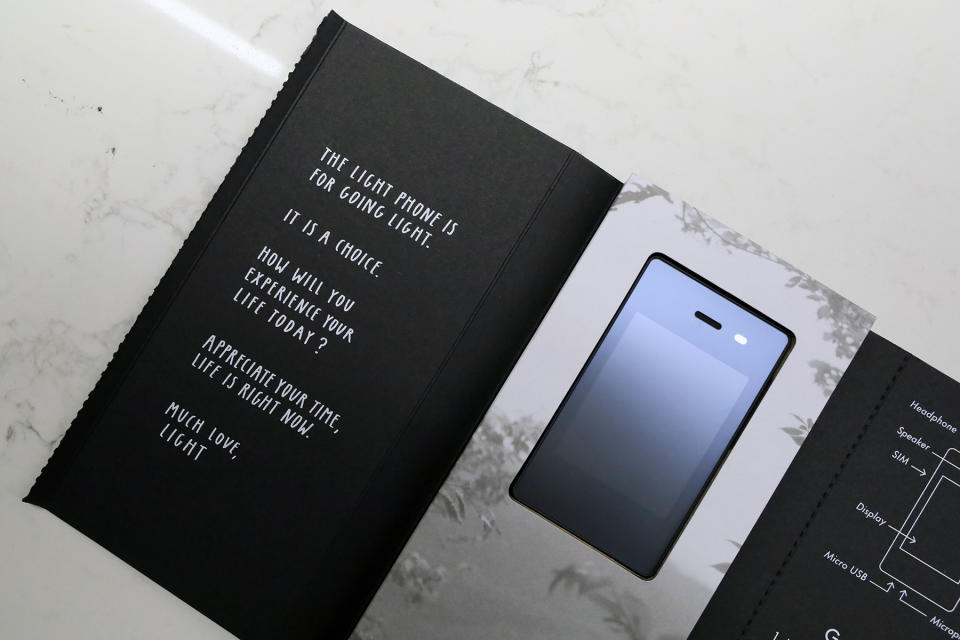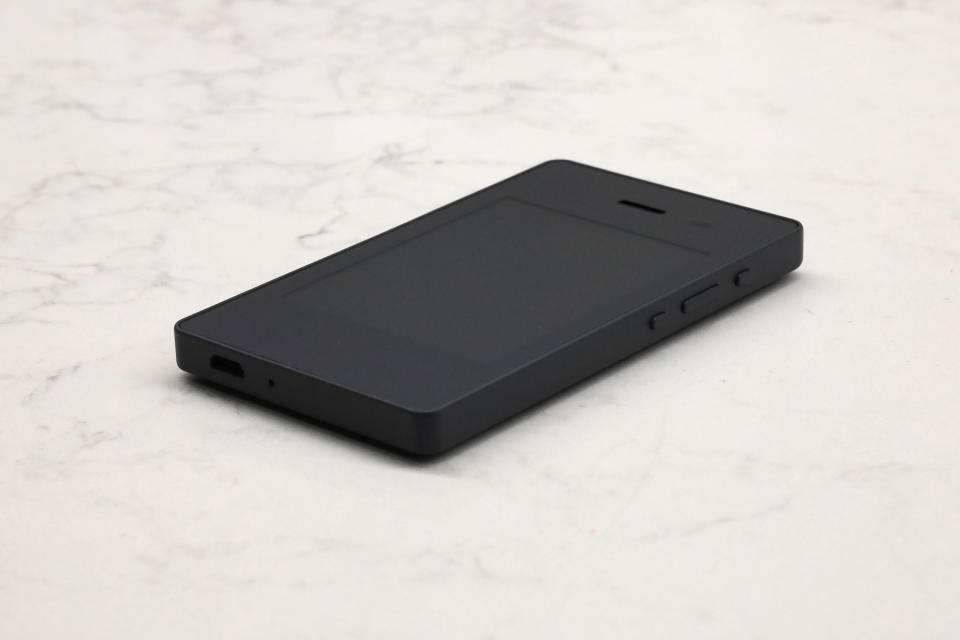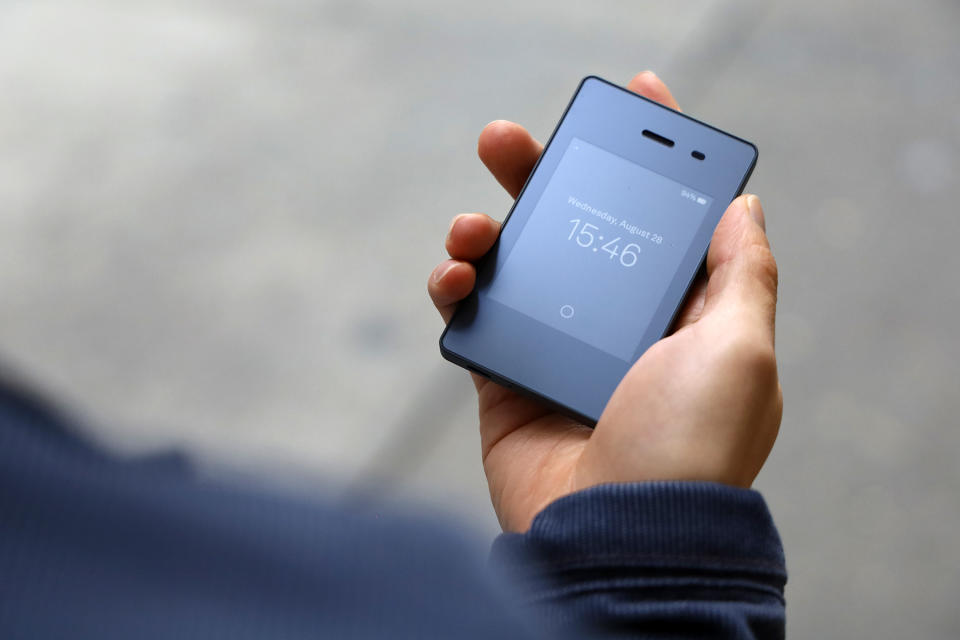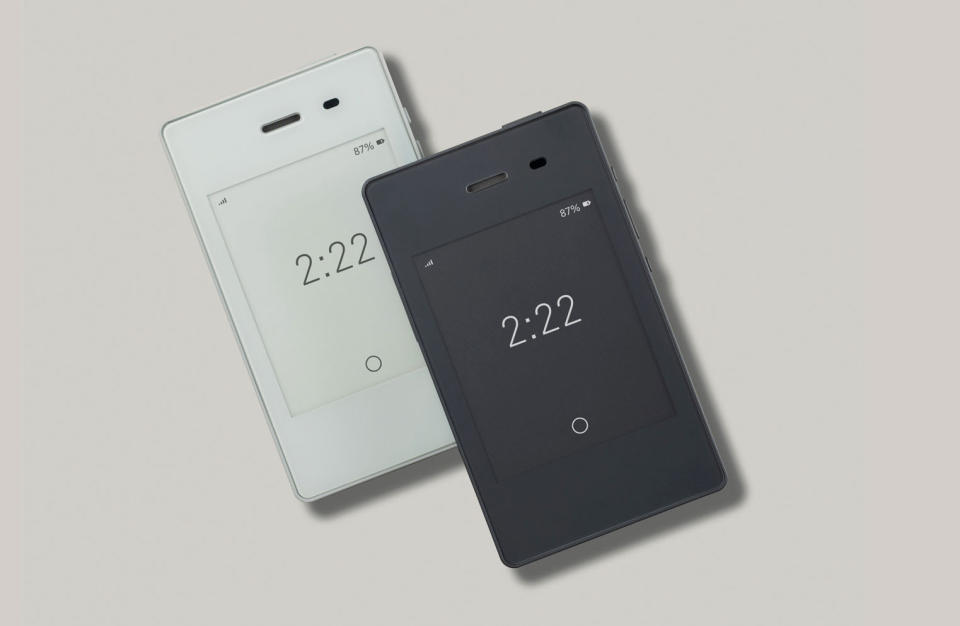The Light Phone II's new idea of phone minimalism
Calmer than a smartphone, smarter than a dumb phone.
Every now and then, a designer decides we all need to spend less time on our phones and sets out to fix that by making us a second phone.
Except not a full bells-and-whistles smartphone. A minimalist phone that lets you disconnect without feeling totally rudderless. For most people, it's a simpler device to use on weekends and vacations; if you can pull it off, it might replace your Apple or Android handset completely.
So far, there have been two main approaches.
The first is to give you everything you'd usually get in a smartphone, in a tiny and unenjoyable format. See: the Palm phone with its 3.3-inch screen, or the Unihertz Jelly Pro whose display measures 2.45 inches. The theory is that you can still do anything you could on an iPhone, but because it's so unappealing to use, you won't dig it out unless you have to. The downside with these devices is that they might just provide the worst of both worlds: all the distractions and little usability.
The other option is an app-less feature phone -- a dumb phone. It could be the shameless nostalgia play of the re-released Nokia 3310 or the fancier, pricier Punkt MP02. The idea is the same: going cold turkey from smartphone conveniences and voluntarily regressing to the days of voice calls and T9 texting. It's better to think of these as emergency phones, a backup for a jaunt into the woods, but hardly a practical daily communication device.
Both approaches are scratching at a real problem -- our collective smartphone addiction -- but neither are truly sustainable options for most people. They speak to the idea that we don't yet have good models for living balanced digital lives. You're either plugged into the Matrix or a radical disconnector -- all-in or all-out
The original Light Phone was all-out. It was released in 2017 via Kickstarter for $150. The credit-card-sized phone made calls and stored a couple of numbers on speed dial. That was it.
Like its predecessor, the new Light Phone II -- available today for $350 -- leans heavily into mindfulness mantras with packaging exhortations to "appreciate your time, life is right now." The device I tried came in a matte and muted dark grey, the opposite of my slick, shiny iPhone. It has a subtle 2.84-inch E Ink display. Like the first Light Phone, it doesn't invite you to fiddle idly with it. But on the inside, the new device presents a different idea altogether.
Beyond the smartphone
The original Light Phone isn't currently being sold as 2G infrastructure phases out in the US -- a 4G version is on the way, but not any time soon. If you're looking for dumb phones with a side of faux-wistfulness, there are the Nokia 3310 and "banana phone" 8110 remakes. Alternatively, if you've got a few hundred dollars burning a hole in your pocket, the $350 Punkt MP02 is a high design but basic feature phone with 4G LTE for internet tethering (the previous MP01 was 2G).
The main mini smartphones on the market are the Palm ($350), Unihertz Jelly Pro ($125) and the newer waterproof and shockproof Unihertz Atom ($260) with an improved battery life.
Further afield, you have Blloc -- designed in Germany -- which looks mostly like a regular Android phone but in monochrome, with a UI that allows you to control most apps from a single screen. It doesn't ship to the US currently. The Card Ketai KY-01L from Japan's NTT Docomo is a 4G feature phone with an E Ink screen intended to be used as a companion device. In India, there's been a rise of the "smart feature phone" like the JioPhone running KaiOS with apps like WhatsApp, though the intention is far less about digital detox than getting the masses online for cheap.

The point of the Light Phone II is not to stop your phone obsession by cutting you off completely, nor by adding undue friction into an otherwise identical smartphone experience. It has 4G LTE, WiFi, GPS and Bluetooth. Instead it addresses the much more interesting but knotty question of which modern conveniences you really need, as well as how to deliver them in a uniquely minimalistic way.
The criteria is that every app -- which the company calls tools -- available on the new phone needs to have a defined purpose and end point. Nothing to monitor, no infinite scroll and, subsequently, no twitchy thumbs hovering over the screen, scanning for app candy. Which means no social media, news, email, web browser or anything advertising based.
"What tools that we don't have, that's the value of what we're trying to do," said Kaiwei Tang, the company's co-founder and CEO. His analogy is that you don't pick up a screwdriver and then get sucked into playing with it for two hours.
"We don't want you to check your Light Phone," said the other co-founder, Joe Hollier.
There's no access to the Google Play store, only the dashboard, a web app that you use to manage your phone from a laptop or smarter phone. The Light Phone team is essentially trying to make custom, minimalist versions of pre-existing apps that they deem worth your time. So, a music tool based on Spotify's API might only give you access to a few predetermined playlists. In lieu of sprawling Google Maps, you might only have turn-by-turn instructions to get where you need.
The issue is that these more interesting apps are nowhere to be seen yet. At launch, the Light Phone II only has calls, texts and alarm functions -- a glorified feature phone for now.
Before the end of the year, according to the company, tools will exist for ride shares, music, directions, tethering and phone tracking (beyond smartphone shunners, the device certainly has potential as a kids' starter phone). Tang and Hollier said the company is still examining partnerships with companies like Spotify and Google Maps, which they're entirely dependent on to make these work. (They should at least have luck with a Lyft collaboration -- the company's president and co-founder John Zimmer is an investor.) Beyond 2019, the team is exploring whether to add voice memos, notes, calendar, weather and a dictionary.
For now, the Light Phone II's customized Android OS works fine, with some thoughtful features. New messages or missed calls are denoted not by a blast of notifications but a single asterisk next to the clock. And you can nix the asterisk if you want. In fact, you can nix the clock. Messaging can also be disabled entirely. You get the idea -- you can choose as much or little phone as you want.
The E Ink is expectedly easy on the eyes, but typing on the keyboard (which requires you to rotate the phone landscape-style every time) is inherently less responsive than on an LCD screen. It doesn't involve T9 levels of resistance but can feel like a plod. E Ink ghosting issues -- the same way you often see the phantom of your last page on a Kindle -- are expected, but when I received emoji (which can be seen but not sent), they often wouldn't show at all until the E Ink screen refreshed. The phone also can't display images sent by message, nor links, because there's no browser.

So say you want to integrate the Light Phone II into your life as a second phone. The simplest method is to get an add-on SIM for your existing plan. Then, every message and call that goes to your primary phone also goes to your Light Phone. (This is presuming you don't want to (a) physically move your SIM card from phone to phone every time you switch, (b) have two numbers, (c) activate call and text forwarding every time you use the Light Phone or (d) depend on the Light Phone as your only phone.)
In the US, this will work through the T-Mobile DIGITS program. The Light Phone II will be compatible with NumberShare, the equivalent program from Verizon (which, full disclosure, is Engadget's parent company) sometime in September and AT&T's NumberSync by the end of the year, according to Tang.
Free alternatives
To be sure, getting a second phone is a privilege. Even after the few hundred dollars for the Light Phone II itself, there's the $10 per month (on T-Mobile) for the second SIM. There's also the hassle of constantly charging two devices and deciding which one to bring with you when.
There's an argument that, instead, you could set up your existing smartphone a certain way -- use a grayscale color scheme, cull your apps, institute rigorous Screen Time or Digital Wellbeing settings. OnePlus even has a Zen Mode now, which effectively makes its phone dumb for a set amount of time. The Center for Humane Technology outlines a lot of the free modifications you could make here.
Tang's counterargument is that a clean break from your apps is most effective: If you're addicted, it's better not to hide the thing you're addicted to in a nearby drawer.
Still, even if your carrier can get you a second SIM, iPhone users will have to disable iMessage, since those texts won't appear on the Light Phone. Contacts also won't automatically sync between iCloud and the Light Phone -- you'll have to manually do that through the web app. Meanwhile, Android users will have to upload a new VCF file of contacts every time they want their Light Phone up to date. After years of having multiple MacBooks and iPhones seamlessly keep calendars, messages and emails synchronized, this is deeply inelegant.
"If these phones can't have that sort of basic functionality that we value so highly, it's going to be really hard for them to find their niche," said Pamela Pavliscak, a professor at Pratt Institute and author of Emotionally Intelligent Design: Rethinking How We Create Products.
"I think that we can't look to [minimalist phones] to solve everything," said Pavliscak. "It's really just one component of a larger problem in the industry, which is how do we balance designing for engagement without designing for addiction?"

What I'm driving at here is that using the Light Phone II on a regular basis will create a lot of problems. Some of those are down to the phone's design, many are down to the current lack of apps (for frequent usage, no WhatsApp is a dealbreaker for me) and some of the biggest are down to wider industry forces, like closed messaging systems or awkward number sharing procedures.
Minimalist phones are not enticing to manufacturers and carriers because with fewer apps available, they're harder to monetize, said Maurice Klaehne, a research analyst at Counterpoint. And for consumers, managing multiple phones is a chore. "We are currently seeing only limited demand for these digital detox products," Klaehne said. "They are more a novelty device."
Which is why the Light Phone's real success may come down to its future software, not its hardware. We're constantly locked in a draining battle with app developers for our attention. We'll pay for something that can edit away the noise.
"We believe the real problem to solve is our relationship with the range of services we use on a daily basis, not so much with the hardware itself," said Rob Girling, co-CEO of design and strategy firm Artefact, which recently published The Tarot Cards of Tech, a kind of checklist for ethical tech design. "We wouldn't need 'minimalist' phones if apps were more responsibly designed for meaningful engagement and less exploitation. Rather than put a lock on the cookie jar, let's start with healthier cookies."
For now, the Light Phone II can provide just enough connectivity for me not to worry that I'm missing something important, and -- hopefully, eventually -- just enough access to modern conveniences, like maps and ride shares and a keyboard to type texts. The first Light Phone was an emergency phone, and right now the Light Phone II is only a partial upgrade. In time, if its tools trim down and redesign our bloated apps, it could be a true minimalist device. Until then, it's merely an anti-FOMO phone.


